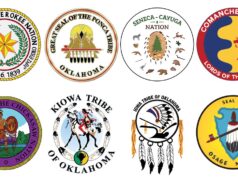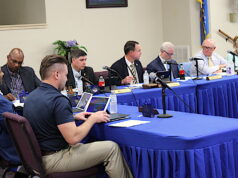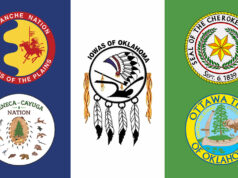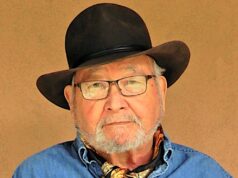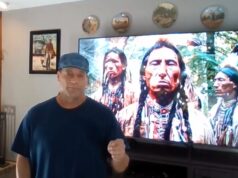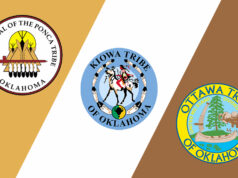

“I can look you in the eye and just about tell sincerity in somebody,” said Dorothy WhiteHorse DeLaune, who built an enduring friendship with a then-10-year-old German actress on a New Mexico movie set.
Along with a Kiowa linguist, WhiteHorse taught Helena Zengel the language and customs of the Kiowa Tribe for the girl’s role in “News of the World,” which stars two-time Academy Award winner Tom Hanks.
“I knew she was a special child. There was nothing snobby or anything,” said WhiteHorse, 88. “If she found me on the set, she’d come over and get her little chair and sit with me.”
This story was reported by Gaylord News, a Washington reporting project of the Gaylord College of Journalism and Mass Communication at the University of Oklahoma.
On Monday, the film received four Academy Award nominations for best original score, best cinematography, best production design and best sound.
“News of the World” was released on Christmas Day 2020 and is based on a 2016 novel of the same name by Texas author Paulette Jiles. The film follows Capt. Jefferson Kyle Kidd (Hanks), a Confederate veteran who travels from town-to-town reading the news, as he seeks to return the 10-year-old Johanna (Zengel) to her last living relative. Johanna had been captured and raised from a young age by the Kiowa after her German settler family was killed in Texas.
“It was a thrilling experience for me at this age,” WhiteHorse said of her work with the movie production. “But I’ve been wanting to tell about our tribe. It has been my lifetime goal. I’m still proud to be a Kiowa woman.”
‘They couldn’t have picked a better teacher’
WhiteHorse was born on Jan. 25, 1933, in a teepee near Anadarko, about 60 miles southwest of Oklahoma City. She is the last remaining survivor of her parents’ 12 children and many more adopted siblings.
WhiteHorse had eight children of her own. She was widowed when she was 50 — never remarried — and prefers to be called by her maiden name.
WhiteHorse is one of just a handful of Kiowa elders left who are fluent in the language. She said she didn’t learn English until she was about 6 years old.
Her family used to hold their Native American church meetings at night, “so the agents wouldn’t catch them and tear down the teepee before daylight,” she said, referring to the federal government’s Indian agents.
“If they were caught practicing any of their things, they were not going to kill us in that time but they were going to withhold their rations and their land allotment money and everything,” she said. “And I grew up like that. And we just kept on practicing.”
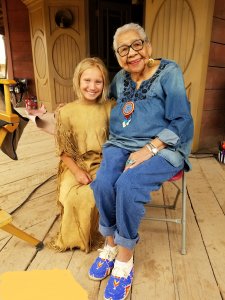
WhiteHorse and the linguist began teaching the young actress the Kiowa language needed for her role nearly a year before the producers invited WhiteHorse and her daughter Lynda to join the set in New Mexico in September 2019. That’s when WhiteHorse first met Zengel in-person.
WhiteHorse gave the child star a beaded cross the first time they met. The second time, WhiteHorse gave her a little doll. Zengel was so touched by the gifts that she couldn’t put them down, WhiteHorse said.
“It’s not every day you have a production and movie crew who want to know more about your tribal history and language,” Kiowa Chairman Matthew Komalty said. “They couldn’t have picked a better teacher than Dorothy WhiteHorse DeLaune. She is our royalty and a tribal treasure. Her teachings and knowledge are irreplaceable. We hold her in high regard and most of all we are proud of her and her accomplishments.”
WhiteHorse said there was a private screening of the movie in Lawton, but owing to COVID, she could only invite a few people instead of the entire tribe. The ones who attended were “just full of wonder” about Zengel’s ability to speak Kiowa, WhiteHorse said.
“I think you have to have something extra to learn our crazy language. It is hard,” she said.
WhiteHorse said Zengel picked up even the most difficult Kiowa sounds easily. Even the way she carried herself was true to the Kiowa way, WhiteHorse said.
“My favorite scene of her is walking by [Hanks’] horse, when there’s nothing but cowboys all over in that scene where she’s walking with the blanket on,” WhiteHorse said. “I have seen them do those shots when I went the first time. The poor little thing’s walking with her hair all over (the place), but that’s the way we actually lived.”
Follow @NonDocMedia on:
Kiowa members impressed with film production
The film was historically accurate with its depiction of the way the Kiowas lived thanks to the research the producers conducted. Gary Tsoodle, 62, a Kiowa Tribe member, said he appreciated the effort.
Tsoodle lives in Anadarko and portrayed the Kiowa chief. He said he watched the friendship grow between Zengel and WhiteHorse. Sometimes, he would see Zengel following WhiteHorse around “just to get more familiarity with the role,” he said.
“I did get a chance to talk with the young lady, and we had a real good talk,” Tsoodle said. “She had a lot of fun on the set. She’s very, very friendly.”
The Kiowa language has a lot of nasal sounds and syllables that sound “spit out,” WhiteHorse said, but Zengel picked it up. WhiteHorse called her “a wonder child.” At only 10 years old, she was already very knowledgeable about Kiowa history, even before learning several lines of the language for her role.
WhiteHorse said Zengel hung onto her quite a bit while she was on the set. The pair has even kept in touch via telephone after WhiteHorse returned to her home in Anadarko.
WhiteHorse is not new to teaching the Kiowa language to children of all ages and ethnicities.
She first began telling Kiowa stories for the Anadarko school system: “Just little old stories to keep the lullabies together,” she said. She once took her class on a field trip to see Palo Duro Canyon in Texas, the final holdout for the Kiowa clan before their removal in the late 19th century.
Around 1875, American soldiers killed all of the Kiowa horses, forcing the tribal members to walk 225 miles east to Fort Sill, WhiteHorse said. They called the event the Wrinkled Hand Chase — wrinkled from walking in the rain during their removal.
“And that was our last hurrah,” WhiteHorse said. “Each tribe, I imagine, has their own Trail of Tears. The Navajos have theirs, and we have ours.”
WhiteHorse still teaches Kiowa to Anadarko students. In her mind, her role in the making of “News of the World” highlights her urgency to pass on her knowledge and wisdom to the next generation.
“There’s not too much time because with this movie, I’ve even had several Kiowas say, ‘Give me your autograph,’ and I say, ‘Hey, I’m going to be 88 years old.’ I have no ambition anymore about trying to do something,” she said. “But the least I can do is tell you about it so you can go on and learn it. Learn our language, learn our history and keep on.”










